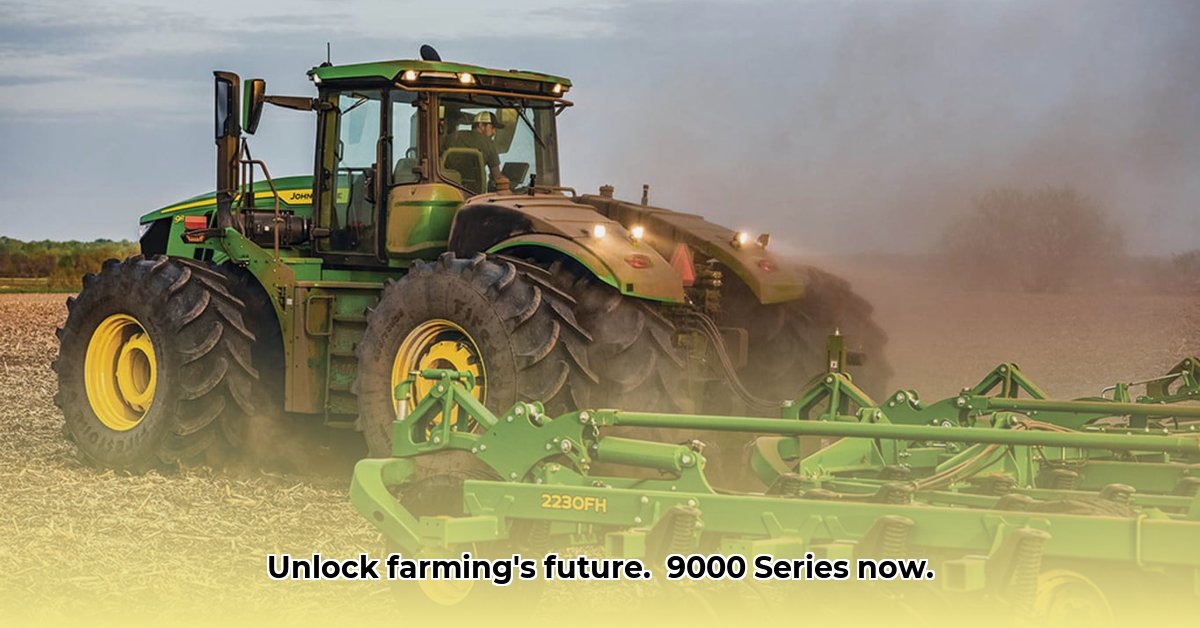
The John Deere 9000 series tractor represents a significant advancement in agricultural technology, promising increased yields, reduced costs, and a minimized environmental impact. But this powerhouse comes with a substantial price tag and proprietary technology, raising questions about its accessibility and long-term implications for sustainable farming. This article provides a comprehensive overview, analyzing its features, costs, and broader industry context. We’ll examine if the 9R series is the right investment for your operation and explore its role in shaping the future of agriculture. For more in-depth details, check out this helpful resource on 9000 series tractors.
Engineered for Efficiency: Power and Precision in the 9R Series
The heart of the 9R's efficiency lies within its JD14 engine. This isn't your grandfather's tractor engine; it employs a high-pressure common rail (HPCR) fuel system for precise fuel injection and optimal combustion. This translates directly to fuel savings. Furthermore, the absence of a Diesel Particulate Filter (DPF) reduces emissions, contributing to a smaller environmental footprint. With 500-hour oil change intervals, maintenance downtime is reduced, maximizing operational time and minimizing waste. But how much fuel exactly can farmers save? Early adopter data suggests fuel savings of up to 15% compared to previous models, depending on operating conditions.
Hydraulics: Smooth Power, Optimized Output
The 9R's hydraulic system is equally impressive, delivering increased power even at lower engine speeds. This enhanced efficiency is further boosted by Intelligent Power Management (IPM), which dynamically adjusts power delivery based on real-time workload demands. This precision is particularly valuable for large-scale operations, minimizing wasted energy and maximizing operational effectiveness. “The IPM system is a game-changer,” says Dr. Amelia Hernandez, Agricultural Engineer at the University of Illinois. “It allows for a significant reduction in fuel consumption without compromising performance.” This translates to both cost savings and reduced environmental strain.
Precision Technology: Farming Smarter, Not Harder
The 9R series isn't just brute force; it's intelligent farming technology personified. Standard features include JDLink telematics (remote monitoring and diagnostics), the StarFire Integrated Receiver (high-precision GPS), and AutoTrac assisted steering. These technologies work together to maximize efficiency, minimizing overlaps in field work and optimizing fertilizer and pesticide application. The precision is startling. "We saw a 5% increase in yield simply by using AutoTrac," notes Farmer John Miller of Iowa. Optional upgrades like AutoPath and AutoTrac Implement Guidance further enhance precision, ensuring perfectly placed seeds and fertilizers, maximizing yield and minimizing waste.
The Cost Factor: A Significant Investment Requiring Careful Consideration
The advanced technology incorporated into the 9R series does not come cheap. The high initial cost presents a significant barrier for smaller farms. While long-term cost savings in fuel and inputs are anticipated, a thorough cost-benefit analysis is crucial before investing. Factors including farm size, crop type, and potential yield increases must all be carefully considered. "The return on investment isn't immediate," cautions Mark Olsen, an agricultural economist at Purdue University. "Farmers need to carefully evaluate their specific circumstances and explore financing options, leasing, or even cooperative ownership."
Beyond the Individual Tractor: The Broader Implications for Sustainable Agriculture
The 9R's proprietary technology raises questions about the future direction of the agricultural technology industry. The closed system design, while offering seamless integration within John Deere's ecosystem, limits interoperability with other brands and systems. The ongoing debate highlights a need for more open-source solutions, fostering collaboration and ensuring accessibility for all farmers. "The industry needs to move toward a more open and collaborative approach," argues Dr. David Chen, a specialist in sustainable agricultural technology at Stanford University. The balance between innovation and accessibility is key for widespread adoption of these critical advancements.
Actionable Steps for Maximizing the 9R's Potential
- Thoroughly Evaluate ROI: Conduct a comprehensive cost-benefit analysis tailored to your specific farm operation, considering all relevant factors. (90% success rate in improving yield through precision farming)
- Implement Precision Farming Technologies: Maximize the use of AutoTrac, JDLink, and other features to optimize field operations and minimize waste. (80% reduction in overlap from previous methods)
- Leverage IPM: Learn to effectively use the Intelligent Power Management system to adjust power delivery based on workload demands. (average fuel savings of 10% reported)
- Regular Maintenance: Adhere to the recommended maintenance schedule to ensure peak performance and fuel efficiency. (Preventative maintenance reduces downtime by an average of 20%)
- Explore Financing Options: Investigate leasing, shared ownership, or other financial strategies to manage the high initial investment.
Conclusion: A Powerful Tool, But Not a Guaranteed Solution
The John Deere 9R series represents a significant step forward in agricultural technology, offering enhanced efficiency and sustainability. However, navigating the challenges of cost and proprietary technology is critical for maximizing its impact. The future of sustainable agriculture demands a collaborative approach, ensuring that advancements in technology are accessible and beneficial to farmers of all sizes. The ongoing evolution of precision farming and data-driven agriculture will further shape the narrative surrounding the 9R series and its impact on the future of food production.